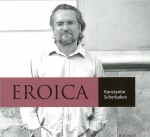 Variations, by their nature, tend toward the cerebral. Pianists who understand this devote a good deal of effort maintaining their ties to the thematic homeland in spite of the distances a composer may travel in his creative wanderings. Konstantin Scherbakov demonstrates this beautifully in Eroica (Two Pianists Records TP1039190) where Beethoven’s Eroica Variations Op.35 journey far on a surprisingly short musical idea. When at times the composer has left little more than a hint of harmonic progression as a fragment of the original idea, Scherbakov finds it and underlines it to remind us of our point of departure. By the time he’s played through all fifteen variations, the closing fugue comes as a highly energized and joyous finale in the form Beethoven so loved to use.
Variations, by their nature, tend toward the cerebral. Pianists who understand this devote a good deal of effort maintaining their ties to the thematic homeland in spite of the distances a composer may travel in his creative wanderings. Konstantin Scherbakov demonstrates this beautifully in Eroica (Two Pianists Records TP1039190) where Beethoven’s Eroica Variations Op.35 journey far on a surprisingly short musical idea. When at times the composer has left little more than a hint of harmonic progression as a fragment of the original idea, Scherbakov finds it and underlines it to remind us of our point of departure. By the time he’s played through all fifteen variations, the closing fugue comes as a highly energized and joyous finale in the form Beethoven so loved to use.
The same disc contains both the Pathétique and Appassionata sonatas. Here, Scherbakov is more formal. He is very aware of the architecture around his musical content and artfully recalls the ideas Beethoven requires in the closing arguments. The Adagio of the Sonata No.8 in C Minor, Op.13 “Pathétique” is perhaps less outwardly emotional than some would like, but this works well in the context of Scherbakov’s overall approach to both sonatas. A strong performer with a clear technique, he has made this a very fine addition to anyone’s Beethoven collection. Production values on this disc are very high despite the fact that the program was recorded in different locations (UK and Moscow).
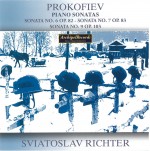 Also recorded in Moscow are Prokofiev’s Piano Sonatas 6, 7 and 9. Digitally restored from original sources Prokofiev Piano Sonatas (Archipel Records ARPCD 465) features three separate public recitals by Sviatoslav Richter from the mid-1950s. Disappointingly bereft of any historical notes about the concerts, the disc is economically packaged but thankfully a little web sleuthing can uncover plenty more about this material. These are among the recordings from the decade that introduced Richter to the West. The audio restoration is wonderful although the somewhat narrow frequency range of the recording reflects the technology of the period. Still, it in no way impedes the colossal technique Richter possessed. His utter control of the wildest passages in Sonatas 6 and 9 stand in contrast to his pensive playing of the Sonata 7 where doleful reflection speaks of the personal burden Prokofiev felt under the Stalinist regime.
Also recorded in Moscow are Prokofiev’s Piano Sonatas 6, 7 and 9. Digitally restored from original sources Prokofiev Piano Sonatas (Archipel Records ARPCD 465) features three separate public recitals by Sviatoslav Richter from the mid-1950s. Disappointingly bereft of any historical notes about the concerts, the disc is economically packaged but thankfully a little web sleuthing can uncover plenty more about this material. These are among the recordings from the decade that introduced Richter to the West. The audio restoration is wonderful although the somewhat narrow frequency range of the recording reflects the technology of the period. Still, it in no way impedes the colossal technique Richter possessed. His utter control of the wildest passages in Sonatas 6 and 9 stand in contrast to his pensive playing of the Sonata 7 where doleful reflection speaks of the personal burden Prokofiev felt under the Stalinist regime.
Richter seems the perfect pianist for this repertoire. Recording two of Prokofiev’s “War” sonatas from the early 1940s (No.6 and No.7) just a few years after Stalin’s (and the composer’s) death, one wonders what the propaganda chatter must have been at the time. The final sonata on the disc, No.9, was written for and dedicated to Richter in 1947. All three of these performances are truly arresting.
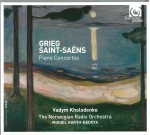 Vadym Kholodenko is the 2013 Van Cliburn International Piano Competition gold medalist. His collaboration with Miguel Harth-Bedoya and the Norwegian Radio Orchestra in Grieg, Saint Saëns Piano Concertos (harmonia mundi HMU 907629) produces thoughtful and unhurried performances. Pianist and conductor are in complete agreement on tempi that favour a more relaxed approach than we sometimes hear. This subtle expansion of time offers the listener an extra moment of consideration before processing the composer’s next thought. The Grieg slow movement is especially exquisite for this reason.
Vadym Kholodenko is the 2013 Van Cliburn International Piano Competition gold medalist. His collaboration with Miguel Harth-Bedoya and the Norwegian Radio Orchestra in Grieg, Saint Saëns Piano Concertos (harmonia mundi HMU 907629) produces thoughtful and unhurried performances. Pianist and conductor are in complete agreement on tempi that favour a more relaxed approach than we sometimes hear. This subtle expansion of time offers the listener an extra moment of consideration before processing the composer’s next thought. The Grieg slow movement is especially exquisite for this reason.
The Saint Saëns Concerto No.2 in G Minor, Op.22 is not quite so restrained. Kholodenko takes the first two movements almost ad libitum alternating between the pensive approach of the opening movement and his dazzling chromatic octave runs in the second. But the third is where he explodes out of the gate with real drama. The palpable energy and crisp articulation make this a performance hard to surpass. This is Kholodenko’s second recording for the label. His third is the Prokofiev concertos the first disc of which we can expect the first disc in 2016.
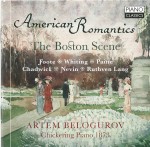 Last month’s column reviewed several discs using period instruments. American Romantics, The Boston Scene (Piano Classics PCL0080) does something similar using an 1873 Chickering grand in a historic Episcopal church in Charlestown, MA. The instrument benefits from modern action and sounds more like a contemporary piano than a fortepiano. Still, its darker colours and unique upper register voicing remind us of its vintage. Pianist Artem Belogurov clearly loves this piano and as much caresses it as plays it. His repertoire choices reveal how much this late romantic American school owed to its European origins.
Last month’s column reviewed several discs using period instruments. American Romantics, The Boston Scene (Piano Classics PCL0080) does something similar using an 1873 Chickering grand in a historic Episcopal church in Charlestown, MA. The instrument benefits from modern action and sounds more like a contemporary piano than a fortepiano. Still, its darker colours and unique upper register voicing remind us of its vintage. Pianist Artem Belogurov clearly loves this piano and as much caresses it as plays it. His repertoire choices reveal how much this late romantic American school owed to its European origins.
It wasn’t until the next generation of composers, the modernists of the early 20th century, that an identifiable American voice began to emerge. Still, this disc’s program helps us understand the creative heritage from which that sprang. Highly programmatic, these short pieces by Foote, Paine, Chadwick and Nevin are beautifully written by composers who knew their craft well. Belogurov commits to them wholly. His playing is sincere and utterly convincing.
The disc is enlightening, entertaining and offers a profoundly satisfying final track with Margaret Ruthven Lang’s Rhapsody in E Minor Op.21. Published in 1895, it’s the most substantial work on the recording and demonstrates a remarkable affinity between composer and pianist, across cultures and generations.
Review
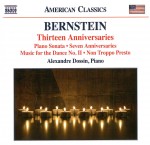 Some four decades later Leonard Bernstein, then in his late teens, wrote his Sonata for the Piano (1938) and Music for the Dance No.2. These two works open and close pianist Alexandre Dossin’s program on Bernstein: Thirteen Anniversaries (Naxos 8.559756). Dossin is Brazilian-born, Moscow Conservatory-trained and now teaches in the U.S. He plays the Sonata with all the boldness and assertiveness that the young Bernstein brought to the page. It’s brilliant music and brilliantly played. The three-movement Music for the Dance is polytonal and angular in rhythm. Dossin understands Bernstein’s structures and always keeps the principal ideas up front for us to follow.
Some four decades later Leonard Bernstein, then in his late teens, wrote his Sonata for the Piano (1938) and Music for the Dance No.2. These two works open and close pianist Alexandre Dossin’s program on Bernstein: Thirteen Anniversaries (Naxos 8.559756). Dossin is Brazilian-born, Moscow Conservatory-trained and now teaches in the U.S. He plays the Sonata with all the boldness and assertiveness that the young Bernstein brought to the page. It’s brilliant music and brilliantly played. The three-movement Music for the Dance is polytonal and angular in rhythm. Dossin understands Bernstein’s structures and always keeps the principal ideas up front for us to follow.
Thirteen Anniversaries from 1988 is the last of four such collections of miniatures Bernstein wrote for his family and numerous friends. A half century separates these from the early compositions on this disc and the difference is remarkable. Dossin conveys what the older composer is feeling. For Stephen Sondheim is a heartfelt tribute to his friend and librettist with very subtle harmonic tilts in the direction of Broadway. In Memoriam: Ellen Goetz is simple and profoundly moving and serves as a fitting close to the set. The 1943 Seven Anniversaries contains tributes to Aaron Copland as well as Serge and Nathalie Koussevitsky and others. Dossin finishes this set with an aggressively energized For William Schumann. All of it is superb.
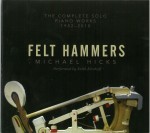 Felt Hammers (Tantara TCD0314FHM) is a collection of the piano works of Michael Hicks played by Keith Kirchoff. This disc is far from common fare but more than a few will like it – a lot. Contemporary and a bit experimental in both composition and performance, the music has titles that reflect strong allusions to the sacred, poetic and philosophical. Still, one hesitates to deem it entirely programmatic. With the piano tuned to Werckmeister III (a tuning system with subtle shimmers in certain keys), Kirchoff plays the instrument in the conventional way, but also stops and plucks strings manually and occasionally adds vocalizations.
Felt Hammers (Tantara TCD0314FHM) is a collection of the piano works of Michael Hicks played by Keith Kirchoff. This disc is far from common fare but more than a few will like it – a lot. Contemporary and a bit experimental in both composition and performance, the music has titles that reflect strong allusions to the sacred, poetic and philosophical. Still, one hesitates to deem it entirely programmatic. With the piano tuned to Werckmeister III (a tuning system with subtle shimmers in certain keys), Kirchoff plays the instrument in the conventional way, but also stops and plucks strings manually and occasionally adds vocalizations.
The core of the program is The Stations of The Cross and its narrative is easy to follow. What raises this composition far out of the ordinary is that Kirchoff has fully captured Hicks’ intention to use the piano in ways that create new and powerfully evocative sonorities. These are sound paintings that strongly project images of Jesus’ journey from condemnation to death and burial. It’s emotionally graphic, though in an abstract way.
The Annunciation is the only piece that extensively uses familiar keyboard technique. Its technical demands are high and Kirchoff meets them capably. The disc opens with a helpful introduction to Hicks’ keyboard language. The Idea of Domes is a simple keyboard tone poem that delivers exactly what its title suggests and prepares the listener for what’s to come. The closing track L’épitaph de Monk is based on Thelonious Monk’s Crepuscule with Nellie and echoes the rhythmic note clusters that punctuate Monk’s original. Those in the target niche for this recording will find it very gratifying.
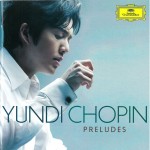 Since winning first prize at the 2000 International Chopin Competition at age 18, Chinese pianist Yundi has scarcely stopped to catch his breath. Countless international tours and 16 recordings later Yundi’s energy is as impressive as ever. His latest disc is Yundi Chopin Preludes (Mercury Classics/Deutsche Grammophon 4811910) which presents all of the Op.28 Preludes plus the Op.45 in C-sharp Minor and a posthumous work as well.
Since winning first prize at the 2000 International Chopin Competition at age 18, Chinese pianist Yundi has scarcely stopped to catch his breath. Countless international tours and 16 recordings later Yundi’s energy is as impressive as ever. His latest disc is Yundi Chopin Preludes (Mercury Classics/Deutsche Grammophon 4811910) which presents all of the Op.28 Preludes plus the Op.45 in C-sharp Minor and a posthumous work as well.
While each on separate tracks, the 24 preludes are produced with very little time between them and give the effect of a larger single piece. This has the novel effect of joining Chopin’s disparate ideas, many less than a minute long, into a statement that he may never have considered. If anything, it allows us a high-contrast glimpse of his remarkable imagination and technique, none of which is beyond Yundi’s grasp. His playing is often unbelievably fast as in the Prelude No.18 in F Minor, but never sacrifices clarity or phrasing. Others like the No.23 in F Major move with an enchanting fluidity. It’s a breathtaking recording and easy to play often for the sheer marvel of it.
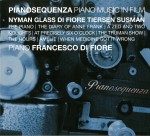 Film music became its own form when musicians first started playing for silent movies. Largely given to supporting and enhancing the emotions portrayed on the screen, film scores occasionally rise beyond their usual task and stand on their own artistic merits. Composer/pianist Francesco Di Fiore has taken this a step further by creating a video and piano performance project using selected shots from a variety of modern films and has reinterpreted the film scores as minimalist keyboard iterations. The studio version of this live project is Piano Sequenza – Piano Music in Film (Zefir Records 9642) and is a remarkably intimate listening experience.
Film music became its own form when musicians first started playing for silent movies. Largely given to supporting and enhancing the emotions portrayed on the screen, film scores occasionally rise beyond their usual task and stand on their own artistic merits. Composer/pianist Francesco Di Fiore has taken this a step further by creating a video and piano performance project using selected shots from a variety of modern films and has reinterpreted the film scores as minimalist keyboard iterations. The studio version of this live project is Piano Sequenza – Piano Music in Film (Zefir Records 9642) and is a remarkably intimate listening experience.
Most of the music selected for this recording was already piano-centric, either written for the instrument as solo or using it to carry the main thematic idea. Di Fiore’s reinterpretations have the effect of being artistic distillations, powerful for their links to films we know well, The Piano, The Hours, The Truman Show and others. And while there is a strong melancholic undercurrent to it all, he infuses it with a clear and uplifting simplicity that has a lingering effect.
Whether he is spinning the ideas of Michael Nyman or Phillip Glass, Di Fiore succeeds in turning the piano into a unique voice, through which we experience the film world of directors Peter Weir, Jane Campion and the others included on this unusual disc.



